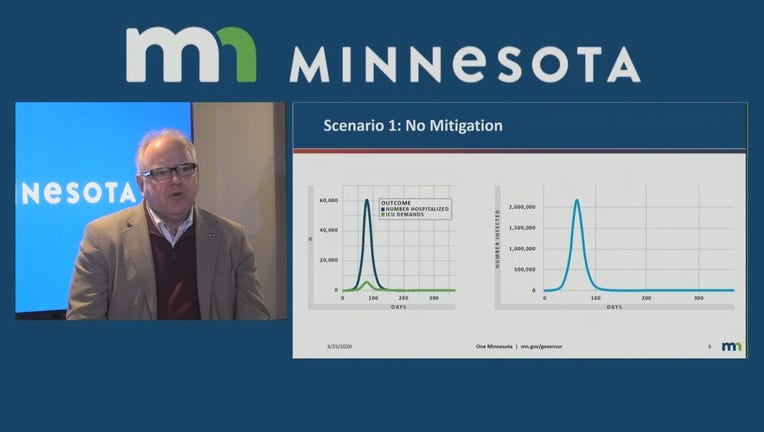Buying time: Minnesota Governor explains stay-at-home order using statistical models

In a news conference Wednesday, Gov. Tim Walz explained, using statistical models, why he decided to issue a stay at home order starting Friday night.
ST. PAUL, Minn. (FOX 9) - Gov. Tim Walz says his newly issued stay-at-home order for the state of Minnesota will reduce physical interaction by 80 percent and buy the state’s health care system “valuable time” to set up more hospital beds.
In his address Wednesday afternoon, Walz showed the state’s modeling data, including a worst-case scenario in which there was “no mitigation” of the spread of COVID-19 and another that strikes a “proper balance” between protecting vulnerable populations and keeping the economy functional.

Gov. Walz announces statewide stay-at-home order as next step in state’s response to COVID-19 pandemic
Minnesota Gov. Tim Walz addressed the state from the governor's residence Wednesday, announcing a statewide stay-at-home order as the next step in the state's response to the coronavirus pandemic.
Scenario 1: No mitigation
The Governor said if the state did nothing to combat the spread of COVID-19, Minnesota would reach full ICU capacity, which is 235 beds, in six weeks.
He said that scenario is like what is currently playing out in Italy.
“That’s what we need to avoid,” Walz said.
In that scenario, the Governor’s model said 60,000 people would be sick by day 63, requiring 6,000 people be admitted into the ICU.
Scenario 2: Changing person-to-person contact
Under current restrictions of schools and other businesses like bars and restaurants, Walz said Minnesotans have reduced physical contact by 50 percent. Under his new stay-at-home order, however, the Governor hopes to increase that number to 80 percent.
He says his two-week stay-at-home order will help the state achieve that reduction. After that, he is asking for three more weeks of physical distancing.

The reason for these measures, Walz says, is to move the virus’ peak in Minnesota to 14 weeks from now instead of six weeks.
By adhering to the Governor’s new restrictions, he told Minnesotans they will have “bought us valuable time.”
During this time, the Governor said the state can work with arenas, stadiums and hotels and motels to convert them into hospitals to help raise the ICU capacity statewide.
According to this model, Walz says on day 150 of the virus, 2 million Minnesotans will have gotten the coronavirus. 85 percent of them will have recovered and 15 percent will be hospitalized.

